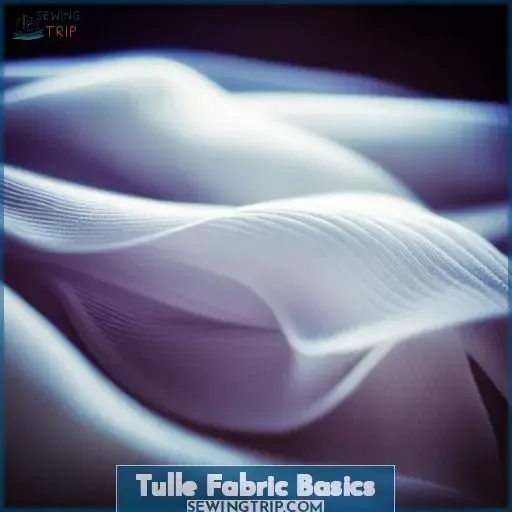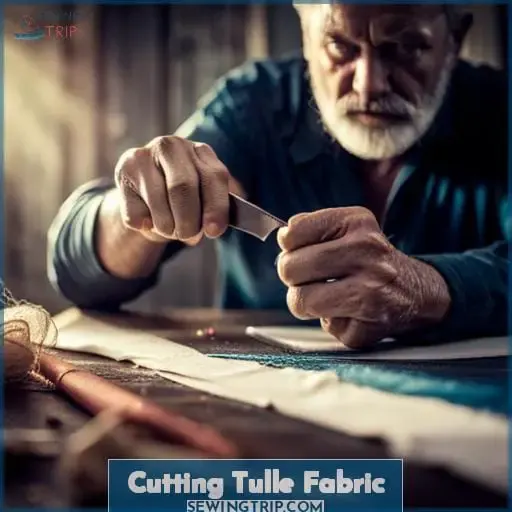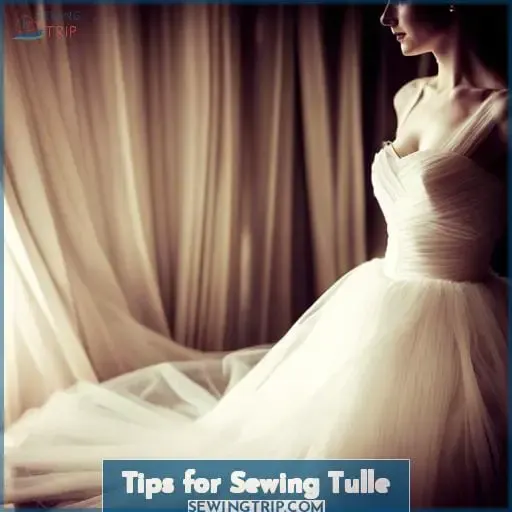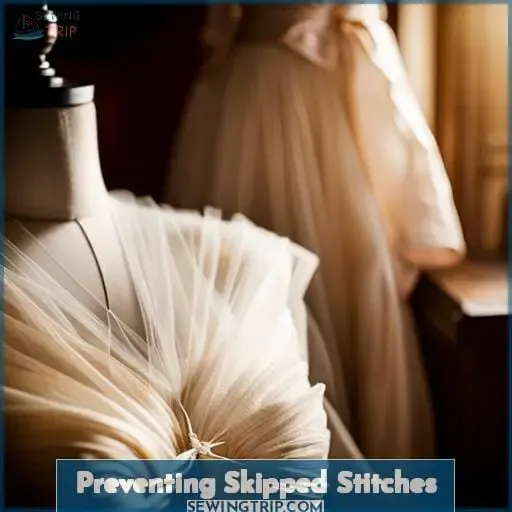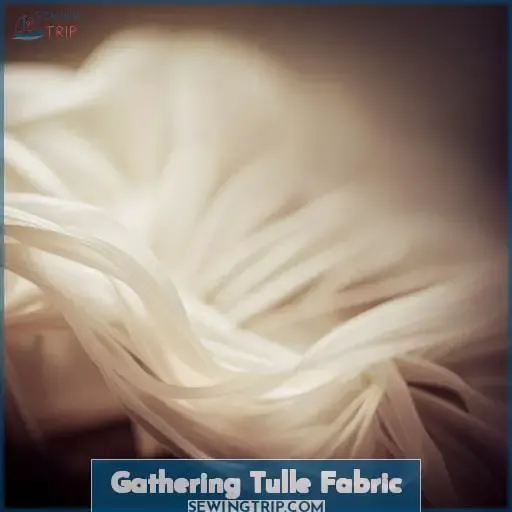This site is supported by our readers. We may earn a commission, at no cost to you, if you purchase through links.

Whip up show-stopping tutus, ballet costumes, veils—whatever your heart desires.
We’ll tackle all the nitty-gritty details:
- The perfect needles ‘n threads
- Preventing those pesky skipped stitches
- Most important—flawless gathering techniques
Then you can flaunt your feminine power, channel your inner creative goddess, and craft stunning tulle masterpieces in a liberating flash.
Let’s do this!
Table Of Contents
Key Takeaways
- Invest in quality tools like a rotary cutter, ruler, self-healing mat, fine machine needles, and sharp scissors for best results
- Pin layers together and tie thread ends securely to prevent snags when working with the delicate material
- Lightly mist tulle with water before sewing to prevent static cling issues
- Use narrow zigzag stitching, silk or polyester threads, tissue paper or stabilizer underneath to avoid skipped stitches
Tulle Fabric Basics
Because the weight of tulle is so light and delicate, you’re working with some unique properties when sewing projects with this fabric.
Tulle requires special handling since its open mesh easily snags, tears, or distorts.
Prevent snags by pinning the layers together and tie off thread ends securely.
When cutting tulle, keep the fabric’s original fold and use sharp scissors or a rotary cutter for clean edges.
Choose lightweight threads and fine machine needles for skipped stitch resistance.
To avoid static cling, lightly mist fabric with water before sewing.
Impress clients with creative embellishments like embroidery, ombre dyeing, ribbon trim, and colorful appliques applied to this sheer, versatile textile.
Master advanced gathering by varying your basting stitch lengths.
With the right techniques, you’ll construct incredible tutus, costumes, and decor from soft tulle.
Tulle Project Ideas
Tutu skirts are a classic way to use gathered tulle.
You can also craft beautiful hair accessories like headbands and flower clips with tulle.
Tutu Skirts
You can now turn your tulle into fun tutu skirts for kids and adults.
Tutus come in endless styles. Pick colors and add rhinestones, sequins, or bows for extra bling.
Size your tutu layers based on the wearer’s hips. For fuller tutus, add more tulle layers.
Adjust the gathering stitches until reaching the proper fullness.
Consider making reversible tutus by using different colors on each side for added versatility.
Hair Accessories
After making adorable tutu skirts, you’re ready to try your hand at gorgeous tulle hair accessories.
Create tulle headbands, DIY barrettes, and tulle hair clips. They’re simple yet elegant.
Sew ribbon headbands or floral crowns using the techniques you mastered sewing tutus.
Gather tulle and add rhinestones or silk flowers for an enchanting, ethereal look.
With just basic sewing skills and creativity, you can design elegant hair accessories perfect for any occasion.
Finishing Tulle Edges
There are several options for finishing tulle edges to make them look polished and complete your projects:
- Add a satin ribbon, velvet ribbon, satin bias tape, or horsehair braid along the raw edge for a clean finish.
- For a fun, whimsical look, try a curly lettuce hem using fishing line.
- Leave the edges unfinished and airy when you want an ethereal look.
Experiment with different techniques to find your favorite tulle edge finishes.
Satin ribbon and velvet ribbon add luxury and elegance to tutus, while the lettuce hem evokes a playful spirit.
Express your inner power and creativity through the tulle finishing touches you choose.
Cutting Tulle Fabric
Now that the tulle edges are finished, it’s time to cut the fabric.
Tulle can be tricky to cut cleanly, so we’ll go over some pro tips.
Invest in a good rotary cutter, ruler, and self-healing cutting mat – this will give you the most control for straight edges.
Fold the tulle while still on the bolt before cutting.
Ensure your blades are sharp! Dull rotary cutter blades will fray the edges.
For patterns, pin the paper pattern to the single layer of folded tulle.
Use weights to keep the slippery layers from shifting.
Cut with firm, even pressure and roll the mat under the ruler as you cut.
Never cut freehand or directly on your work table. This will lead to inaccurate and uneven shapes.
Here are some key cutting tools that will elevate your tulle projects:
| Tool | Benefit |
|---|---|
| Rotary cutter | Clean, straight edges |
| Cutting mat | Protects work surface |
| Transparent tape | Holds tulle to cutting mat |
With the right supplies, cutting tulle fabric can be frustration-free.
Now let’s move on to sewing this ethereal material.
Tips for Sewing Tulle
How carefully should you sew with tulle to prevent issues? Very carefully! Tulle requires more finesse than other fabrics.
Follow these 4 tips for frustration-free tulle sewing:
- Use fine, sharp needles like jersey/ballpoint needles to pierce the netting without damaging fibers.
- Set your machine to a narrow zigzag stitch to allow for stretch, and sew slowly.
- Use silk or polyester thread to avoid breakage, and knot ends securely.
- Place tissue paper or stabilizer underneath to prevent skipped stitches.
With the right needles, threads, stitch settings, and stabilizers, you’ll find tulle is delightful to embellish into tutus, hair accessories, bags, and other creative projects.
Troubleshoot any issues by adjusting tension, speed, and needle size.
Happy tulle sewing!
Choosing Needles and Thread
- For sewing or gathering tulle, use fine needles like jersey or stretch varieties to avoid snagging the delicate tulle fabric.
- Match your thread color closely to the tulle so the stitches blend in seamlessly.
- Remember to knot the thread ends securely so your gathers don’t loosen up.
Pinning Fabrics Together
You’ll need some special tricks for pinning tulle layers together securely.
When gathering tulle, use long ballpoint pins or curved safety pins to pierce multiple layers.
Space pins closely, about 1-2 inches apart, along the seam lines to prevent shifting while handling the fabric.
These pinning techniques help maintain precision for stitching the final seam.
Knotting Ends Securely
- Secure thread ends by knotting them when beginning and ending stitches on tulle fabric.
- Use simple overhand knots initially.
- Switch to surgeon’s knots on gathered tulle to prevent loosening.
- Practice knots frequently when first sewing tulle to master secure knotting techniques for flawless gathering and fastening.
Matching Thread Colors
You’ll want to match your thread color to the tulle when sewing and gathering tulle projects.
Select the exact shade for seamless blending.
Go one shade darker for subtle contrast.
Try a bold complementary color for drama.
Mix varied hues for eclectic combinations.
Preventing Skipped Stitches
When sewing tulle, you can prevent skipped stitches by:
- Using a fine jersey needle.
- Slowing down your sewing machine speed.
- Placing a small piece of tissue paper or tear-away stabilizer underneath the layers.
To avoid skipped stitches, consider using the following techniques:
- Use a Teflon foot to help glide over the slippery surface of tulle without sticking or snagging.
- Place clear tape on the bottom of your presser foot for added traction when sewing delicate fabrics like tulle.
- Switching to a zig-zag stitch instead of straight stitching can provide more flexibility while working with stretchy tulle fabric.
- Securely pinning layers together with safety pins before stitching will help keep them aligned during sewing and prevent shifting.
Using an iron set on low heat or steamer along with pressing cloth is effective at removing wrinkles from delicate tulles.
By implementing these strategies into your sewing routine when working with tulle fabric, you’ll achieve better results and avoid frustration caused by skipped stitches.
Gathering Tulle Fabric
Next, identify the desired gathering point on your tulle. Mark the point with pins or a disappearing fabric marker.
Decide the desired length of the gathered tulle.
- Set the sewing machine to a basting stitch.
- Change the stitch length to 6 mm for long basting stitches.
- Sew basting stitches along the tulle until reaching the end.
- Cut the thread and remove the tulle from the machine.
- Pull gathering stitches from the starting and ending points.
- Push the fabric gently while pulling.
- Arrange tulle gathers evenly.
- Pull gathering stitches until the desired length is achieved.
Insert a pin at each end of the fabric.
Wind excess gathering threads around pins.
Set the sewing machine to a regular running stitch and change the stitch length back to 2.5 mm.
Place the tulle back on the machine and stitch over the basting stitch to set gathers.
Securing Gathers
The process of fastening your tulle gathers:
- Insert pins at both ends of the fabric.
- Wind extra gathering threads around the pins.
- Reset the sewing machine to a regular running stitch.
- Stitch over the initial basting stitch to permanently set the gathers.
To secure the ends of the fabric:
- Pin both ends of the fabric, catching the gathering threads.
- Neatly wind any excess gathering thread around the pins to keep everything tidy.
To set the gathers:
- Reset your sewing machine to a regular 2.5mm running stitch.
- Place your pinned tulle back under the presser foot.
- Stitch over your initial long basting stitch to permanently set the gathers in place.
- Go slowly and carefully to catch every part of that first gather stitch.
- Use matching thread so your securing stitches blend right in.
Even gathers are the goal for any dreamy tulle skirt!
Removing Static in Tulle
After securing those fabulous gathers in your tulle skirt or tutu, you may notice annoying static electricity causing the fabric to cling.
Mist the tulle with a half-water, half-Downy fabric softener spray. The softeners help relax fibers.
Controlling home humidity levels between 40-50% also reduces shocking.
When sewing, stop periodically to touch something metal to ground yourself.
Static can be frustrating when handling delicate tulle, but these tricks will have you flowing freely to finish sewing gathers in gorgeous gathered tulle skirts with ease.
Frequently Asked Questions (FAQs)
How do I wash and care for a tulle project once it’s finished?
When finished, gently hand wash your tulle creation in cool water with a mild detergent.
Reshape while damp, lay flat to dry.
Steam press if needed, using a pressing cloth to avoid scorching the delicate fabric.
Handle with care and your ethereal tulle project will maintain its magical allure.
My tulle fabric is very wrinkled. What’s the best way to remove wrinkles?
Lay the wrinkled tulle flat.
Hover a steamer over it without touching.
The steam will relax the fibers and release the wrinkles.
For stubborn creases, cover with a pressing cloth.
Gently press with an iron on low heat.
This preserves the delicate netting so you can sew beautifully.
What kind of interfacing or underlining should I use with tulle?
Use lightweight interfacing or mesh to support the tulle without weighing it down.
Press fusible interfacing to the wrong side of the fabric.
For firm structure on necklines or hems, try horsehair braid or hem tape.
Now you can create ethereal gathered tulle projects.
I want to add sequins, beads, or other embellishments to my tulle project. Any tips?
Add sparkle by hand-sewing sequins or gluing rhinestones.
Go slowly and carefully to avoid snags.
Embellishments will make your tulle project shine, so take your time to do it right.
The feed dogs on my sewing machine are catching on the tulle. What can I do?
Replace the regular presser foot with a walking foot or Teflon foot.
These will smoothly glide over the tulle without catching like the regular foot.
Be sure to also slow down the sewing speed significantly for best results.
Conclusion
What a fabulous foray into tulle, darling!
With some pluck and our guiding hand, you’ve gathered the goods on gathering.
Now unleash those imaginative juices, grab your needle ‘n thread, and stitch up sublime tulle confections with flair.
Flaunt those feminine wiles or build ballerina dreams – the possibilities with tulle are endless.
So craft on, goddess, and let your inner light shine through sensational tulle creations.

